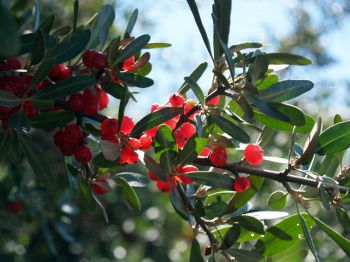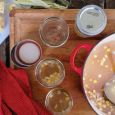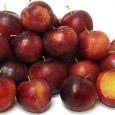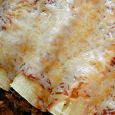The Gift of South Dakota
Subscriptions to South Dakota Magazine make great gifts!
Subscribe today — 1 year (6 issues) is just $29!
Buffalo Berries
At the edges of plateaus, wind and water erosion often cuts into the limestone to create small canyons, little habitats that are less arid than the surrounding plains, biological marvels: the Hanging Gardens of Dakota. Several kinds of bushes and trees, besides buffalo berry, favor this habitat: plum, currant, chokecherry, and sumac flourish under stunted cedars. Technically, the buffalo berry is Shepherdia Argentia, a perennial member of the Oleaster family. The shrub is seldom more than 6 feet tall, though one source says it can grow to 25 feet. The leaves are modestly silver on one side, gray and scaly on the other; brown flowers appear in May and June.
I have often thought the buffalo berry was designed with greedy humans in mind. You know the ones: they associate size and glitter with quality. It's not love that counts with them, but the size of the diamond. They don't care how a car runs; their eyes shine at spoke wheels, shiny red paint, a large price tag. These folks won't notice the boring buffalo berry, even when it's covered with berries that range from golden to a deep, brownish red.
The flavor of buffalo berries is incomparable. It most closely resembles alum, a cooking ingredient you probably will no longer find in your kitchen if you don't make pickles. One-quarter teaspoon of alum, or a handful of buffalo berries, makes your mouth feel like you are eating Death Valley. The secret of buffalo berries is this: it's impossible to eat them from the bush. They are the ideal harvest berries because you get what you pick.
Their other hidden weapon makes buffalo berries the elite among wild fruit. The thorns can be up to six inches long, all scientifically placed so you cannot pick a single berry without puncturing naked hands. Even leather gloves don't save you from injury. Some experts say buffalo berry pickers should wait until the first frost loosens the berries, then spread a white sheet on the ground under the bushes, and shake the branches vigorously to dislodge the fruit. When I've waited for frost, I found the bushes bare, the ground decorated with a few shriveled berries and millions of grouse footprints. I heard miniature belches and the distant thunder of the flock waddling away. That's the time to shoot a grouse, if you can see the little masters of camouflage. Then gently slit the crop, rinse the berries he's eaten, and replace his intestines with them; roast him for an hour, and enjoy his succulent flesh with buffalo berry sauce.
The only really effective way to pick buffalo berries is to put on elbow-length leather gloves, a long-sleeved denim jacket over a long-sleeved shirt, and tuck the bottoms of your pants firmly into your boots to keep some of the ticks from crawling up your legs. The worst is yet to come. The berries are stuck to the branches, so you have to work to harvest them. On the other hand, they hang in clusters; each determined tug should give you about 10 berries. Then all you have to do is get them into the bucket without dropping the whole bunch.
One hot day, we picked two buckets in about a half hour. We left a large number of berries for the grouse: all those hidden in the tumbleweeds where we didn't want to reach for fear of rattlesnakes, and the berries higher than we could reach.
Unlike plums, buffalo berries don't have to be laboriously separated from their seeds, or peeled. Simply fill the bucket with water, and float the leaves and debris off the surface. Then drain off excess water, and dump the berries into a large cooking pot with a little water. Those who prefer the security of a recipe should use the sour cherry jelly recipe on a popular brand of fruit pectin, and substitute apple juice for one-third to one-half of the water. I use half or less of the amount of sugar prescribed, because I appreciate the berries' tartness. When the juice has been boiled away from the seeds, I strain it before adding sugar for the second cooking.
The jelly is a tawny peach color, and the flavor is hard to describe. I might compare it to apple pie with lemon: sweet, extra tangy. But another element lurks in the flavor that I can't compare to anything else. I think it's the essence of wildness, clean prairie air made solid. It contains the deer that nibbled the leaves in winter, the beating of grouse wings as they pick berries from the highest branch, the blundering invulnerability of a porcupine living under the ledge. It's the taste of blinding white drifts slowly being built and smoothed into glittering sculpture outside the house as you make morning toast, slathering it with butter and buffalo berry jelly. The jelly brings the flavor of summer heat to your tongue, a sheet of sweat to your shoulders; even as you watch the blizzard, it reminds you of spring fragrance and the cool nights of fall.
And there's something more. Buffalo berries are symbolic, to me, of the answer to the question all plains people are eventually asked.
"Why," the questioner will ask, looking around just before he gets back on the plane that will take him back to some metropolis, and smiling a little disdainfully, "Why do you stay here? You could be anywhere; you could make more money, have all the advantages. I know it's beautiful, but ... " The questioner will shrug, wait a few seconds for an answer that doesn't come, and tum to climb the steps to the seats between the mighty engines which may or may not fall off during his escape from the plains.
I want to say, "Because of the buffalo berries." These tart little berries on hidden, thorny bushes are what the modern people of the plains have become. We're not easy to find, and we tend to be a little prickly if we've been here long. Hardship and freedom breed stoicism, and don't leave us with much patience for such questions. But when you get to know us, when you understand a little of our plains habitat, we're rare and tasty.
Though it's difficult to transfer hot jelly from a large pan into a tiny glass, I use my smallest containers for buffalo berry jelly. Almost none of it leaves the ranch. The people I give it to can be counted on the fingers of one hand bloodied with picking berries, and include the best people I know. A few years ago I published in one of my books a map of our ranch; I included specific directions that made my family a bit nervous, and a lot of detail: where the horse stepped on me, where my favorite horse is buried, the dam where the coyotes hunt. I've paid for my candor every time someone uses the map to drive into my yard and ask for a "tour of the ranch." But even while being so naively forthright, I didn't put in the ravines where buffalo berries grow, and it's no use asking me. Find your own. Like Mother Nature, I can be harsh; like her, I've given you fair clues to their habitat.
And while you're looking, you might come to understand what we are doing here, and that knowledge will be something else you can savor through a long, cold winter in some sooty, crowded city.
Editor’s Note: This story is revised from the July/August 1991 issue of South Dakota Magazine. To order a copy or to subscribe, call (800) 456-5117.











Comments
Once we had bags of fruit and nuts ( and a bit of pine gum I would collect to chew) we would go home and roast the nuts and put the berries in ziplock bags and a cup of sugar on top. Similar to how people do strawberries.. We rationed to last the winter, so when Mom let us have them for dessert it was a treat. We took fresh cream from the cows we milked and and poured it over the berries and just ate (tart) berries and cream. I do remember the thorns, since we picked bare handed and did eat a bit of them as we picked..
after you pick them freeze them they get more tasty and make great jelly for toasfn ice cream. Little tart but once you get use to them you will like them.